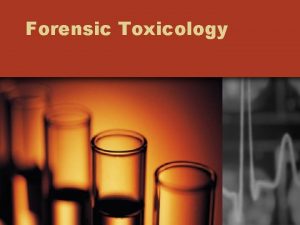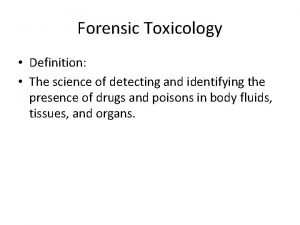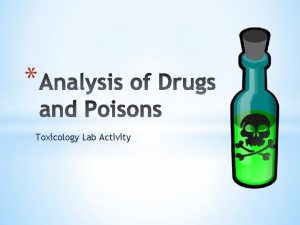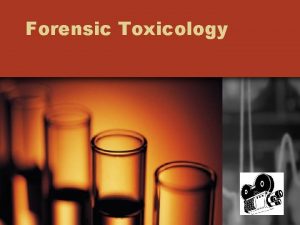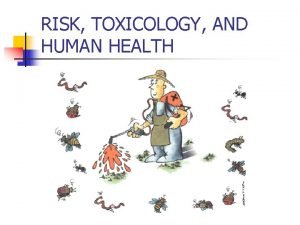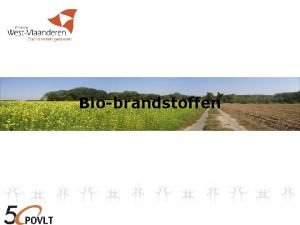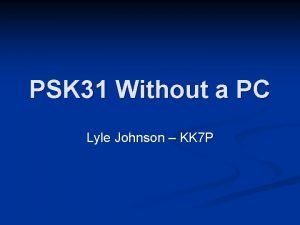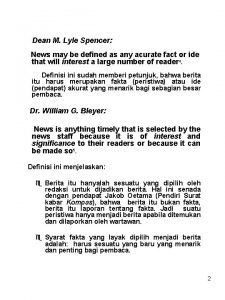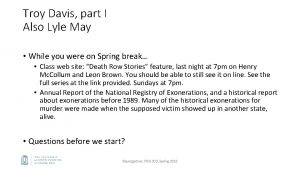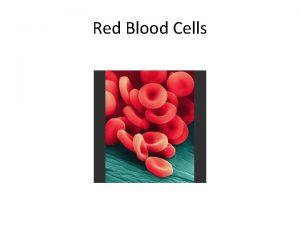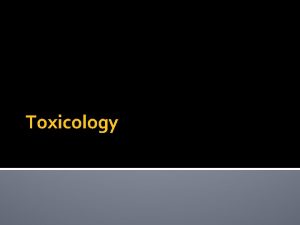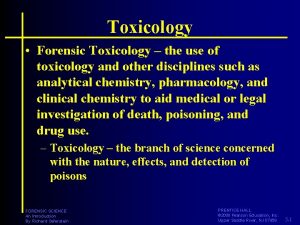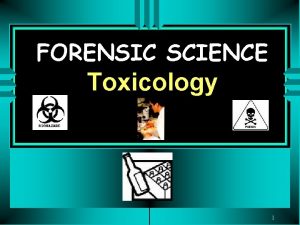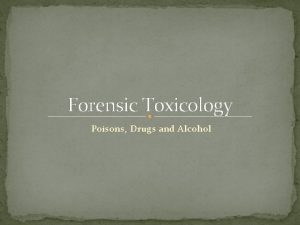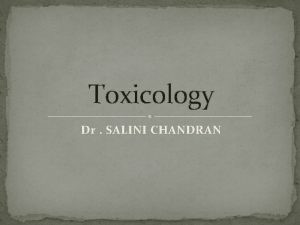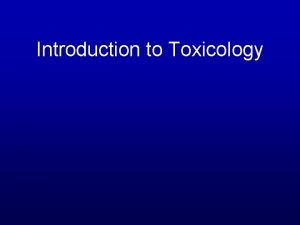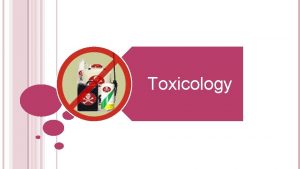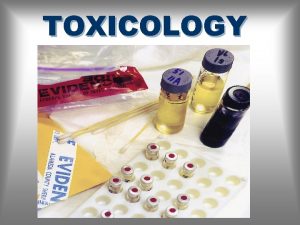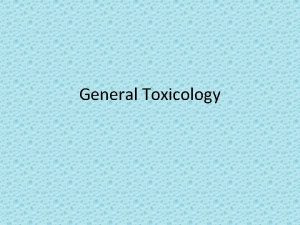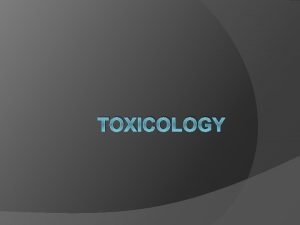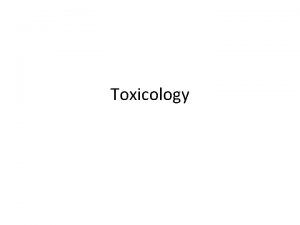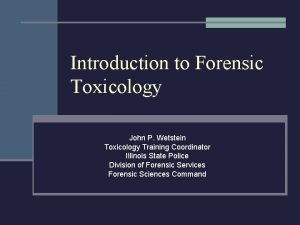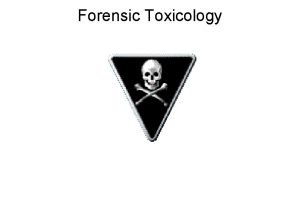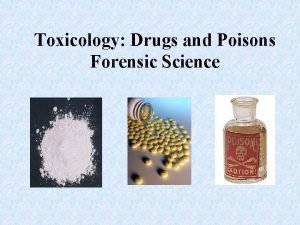Forensic Toxicology Adapted from The Mystery of Lyle























- Slides: 23

Forensic Toxicology Adapted from The Mystery of Lyle and Louise (www. crosscuttingconcepts. com I

History of Forensic Drug Testing � 1830’s: James Marsh was summoned to testify in the trial of James Bodie was accused of killing his grandfather by putting arsenic in his coffee. Marsh had been working on a test for arsenic. �Original test: Sample + H 2 S + HCl (yielded an unstable product that would indicate arsenic but deteriorated quickly) �Reasonable doubt led jurors to acquit. Marsh returned to the lab and refined his test: � Sulfuric acid and arsenic-free zinc is mixed with the sample. If arsenic is present in the sample, arsine gas is produced which when ignited leaves a metallic arsenic residue that is stable. � Karl Landsteiner’s work with blood led the way for blood to be used as a testing sample.

Forensic Toxicology �The branch of forensics that performs testing and analysis for drugs and chemicals that may be related to or found at a crime scene. �Common samples: �Blood �Urine �Hair �Body fluids �These may be recovered from a crime scene, be in an individual’s possession, or acquired for drug screening tests by schools, sports or employers.

Drug screening versus compound identification �Drug screening: the expert is looking for a particular substance �Example: �a urine drug screen may be ordered by a coach to see if an athlete is using a particular steroid. �An employer suspects that an employee is smoking marijuana at work. A drug screen sample is obtained and testing for THC. �Compound Identification: an unknown substance is identified through running multiple tests to determine if controlled or illegal substances are present.

�In the United States, an estimated 75% of evidence obtained by law enforcement is drug related. �Some drugs can be identified visually: �Marijuana (www. radicalruss. com) �Intact prescription pills (have a stamp that identifies the drug) (wwwl. cvs. com)

�It is, however, impossible to determine the identity of a zip-lock bag of white powder by simple visual examination. methampheta mine cocaine aspiri n

� State and Federal guidelines determine the level of charge brought against a person who is in possession of an illegal substance. � Knowing the exact substance and specific amount can mean the difference between a misdemeanor charge and a felony charge. � Penalties also differ from substance to substance. Each offense is taken seriously and subsequent arrests net harsher penalties including larger fines and prison time. � Qualitative tests can define what type of drug is present but cannot tell how much drug is present � Quantitative tests use a mass percentage to determine the amount of drug present in a sample � http: //www. ncleg. net/Enacted. Legislation/Statutes/HT ML/By. Section/Chapter_90/GS_90 -95. html

Drug Testing �Commercially available screening kits allow law enforcement to conduct presumptive screening in the field. �Advantages: �Can be done at the crime scene �Gives quick initial identification of a particular substance �Assists in quick decisions in the field �Reduces the number of samples sent to the laboratory �Cost saving method; only positive tests must be sent to lab to confirm �Can rule out substances �Disadvantages: � False positive results due to interfering substances

Presumptive Tests �Most rely on interpreting a color change (colorimetric) �Direct testing of the questioned substance or indirect testing of blood, urine, saliva or other body fluids. �Highly sensitive/no expensive equipment �Many use sulfuric acid which reacts with the unknown to produce the color change which is read against a reference color �Others rely on a specific odor such as the test for cocaine which produces a fishy or minty smell.

Presumptive Tests T ype Chemicals Used Postive Color results Marquis color Formaldehyde, sulfuric acid Purple: heroine, morphine, opium compounds Orange-brown: amphetamine Cobalt Thiocyanate Cobalt thiocyanate, distilled water, glycerin, hydrochloric acid, chloroform Blue: cocaine Dillie-Koppanyi Cobalt acetate and isopropylamine Violet-blue: barbituates Duquenois-Levine Vanillin, acetaldehyde, ethyl alcohol Blue-purple: LSD Van Urk PBlue-purple: LSD dimethylaminobenzalde lyde, hydrochloric acid, ethyl alcohol

Confirmatory Tests �Used to confirm a positive result from a presumptive test and accurately identify substances so that drug evidence can be admissible in court �Advantages: �More specific �Accurate �Less risk of false positives �Disadvantages �Expensive equipment is needed �Requires a forensic drug chemist to analyze the information produced by the machine

Gas Chromatography-Mass Spectrometry (GC-MS) �Gas chromatograph �Reduces the structure of the chemical compound to individual molecules based on chemical properties �The molecules travel through a column and take different amounts of time to exit allowing the mass spectrometer to capture and detect each individual molecule. �The GC produces fragments and the MS classifies the chemical compounds. It creates a ratio with its mass and electrical charge called the mass-tocharge ratio.

Diagram of the GC-MS www. chromacademy. com

Ultraviolet Spectrophotometry �Similar to GC-MS �Unknown is identified through detection of the light being reflected by the main elements of a compound �The results are analyzed and compared to a known sample range to identify the unknown drug

Quality Assurance �Testing methods must be accurate and produce expected results with known control samples that are positive and negative for a given drug. These control samples ensure that the test is working properly. If control samples do not produce the expected results the test is considered “Invalid”. �Testing laboratories must follow procedures as written in the procedure manuals. Only one sample should be open and tested at a time. Chain of custody is important and must be followed at all times.

Common Illegal Substances �Marijuana �Most widely used hallucinogen �Tetrahydrocannabinal or THC is the active substance that ranges from 1 to 20 percent (in female marijuana flowers) �Cocaine: �stimulant made from the coca plant grown in the Amazon �To produce on pound of cocaine, 500 pounds of coca plant is needed �Most is made into a powder and snorted or crystallized and heated into fumes to be inhaled (crack) �Acts on the central nervous system to produce alertness and energy. Decreases the appetite and

�Methamphetamine �Highly dangerous drug abused for its feelings of euphoria �Can be injected, snorted, smoked and ingested orally �In controlled doses it is used to treat ADHA, obesity and narcolepsy �Meth addicts develop a condition called “meth mouth” because they don’t seek dental care and use money for drug habit instead. They also can develop sensations of bugs crawling under the skin which causes them to scratch the skin and develop sores.

�Opioids �Widely used as a pain killer prescribed by physicians �Acts on the neuron receptors in the brain and spinal cord to block pain signals �Examples: vicodin, lortab, morphine, some cough medicines �Derived from harvested opium plant seeds

Alcohol � Over 31% of traffic fatalities in 2010 were alcohol related. � Field sobriety tests: �Walking the line �Touching the nose with eyes closed �Reciting alphabet backwards These types of tests do not quantify the amount of alcohol nor do they confirm that a driver is over the legal limit. � Portable breathalyzers: instrument that is able to quantify the amount of alcohol in the suspect’s blood by calculating the alcohol content of the “breath” blown into the device. � A confirmatory test (usually a blood or urine alcohol test) is done following chain of custody in order to be admitted as evidence in court.

Alcohol Absorption/Evaporation � Alcohol gets absorbed from the stomach and intestines into the bloodstream. Some alcohol gets broken down in the stomach due to an enzyme present in the stomach acid. Males tend to produce more of this enzyme than females. As a result, males tend to be able to consume more alcohol than females before the results are felt. � Alcohol is not chemically changed in the bloodstream. � As blood passes through the lungs, some of the ingested alcohol moves across the membranes of the lungs air sacs into the air and evaporates. � Ratio of 1: 2100 (concentration in lungs/concentration in blood)

Legal Limits �American Medical Association: person can become impaired when BAC hits 0. 05 which means that there is 0. 05 grams of alcohol per 100 ml of blood. �All 50 states have 0. 08 as the legal limit with even lower limits for truck drivers and persons under 21.

Testing Devices: � Fuel cell method: � chemical reaction generates an electrical signal in response to the breakdown of alcohol in the fuel cell � Fuel cell converts alcohol and water to acetic acid, H+ and electrons at the anode � At the cathode, H+ and electrons combine with oxygen to regenerate water. This produces a flow of electrons from anode to cathode. This flow is measured and signal is displayed. � Higher alcohol level = more electrons produced � https: //youtu. be/rv. Vzlg 26 b. CM � Infrared Spectroscopy: � based on the premise that all compounds absorb some infrared radiation at particular wavelengths because of their chemical bond arrangement � The infrared spectrum of an unknown is compared to the spectra results of known compounds to identify the unknown.

Factors that affect alcohol tests �Drinking on an empty stomach (faster metabolism) �Drinking with a fever (false positive) �Using mouthwash or breath spray (false positive) �Nyquil �No good way to spoof the systems. �https: //youtu. be/D 7 gb 8 v 9 R 3 m 8
 History of toxicology slideshare
History of toxicology slideshare Definition of forensic toxicology
Definition of forensic toxicology Important dates in forensic science
Important dates in forensic science Forensic toxicology lab activity
Forensic toxicology lab activity Reinsch test
Reinsch test Forensic toxicology vocabulary
Forensic toxicology vocabulary Serial number restoration
Serial number restoration Thomas mocker and thomas stewart
Thomas mocker and thomas stewart Who is this
Who is this Alpha kappa alpha graduate chapter letter of invitation
Alpha kappa alpha graduate chapter letter of invitation Tyte&lyle
Tyte&lyle Lyle alzado cause of death
Lyle alzado cause of death James lyle johnson
James lyle johnson James lyle nist
James lyle nist Pnwvhfs
Pnwvhfs Lyle c may death row
Lyle c may death row James lyle md
James lyle md How have plants adapted to the rainforest
How have plants adapted to the rainforest Thinking synoynm
Thinking synoynm Xerophytic adaptation
Xerophytic adaptation Brother quotes from brother
Brother quotes from brother Red blood cells are
Red blood cells are Spermopsida as successful land plants
Spermopsida as successful land plants Behavioral adaptations of zebras
Behavioral adaptations of zebras
